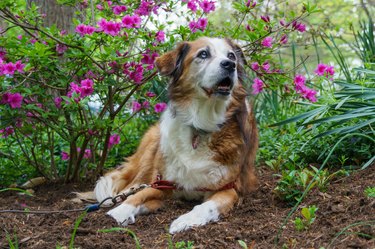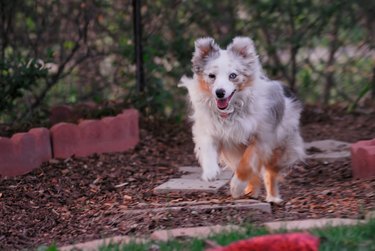Natural wood chips for dog kennel
Pine mulch is a good ground cover option for your dog run. Pine mulch is soft, economical, and provides a comfortable layer of bedding when your dog lies down and shock absorption when he runs. Cedar mulch is also effective, but its a good idea to initially test your dog for allergic reactions. The first time your dog walks on the cedar mulch, monitor your pups skin for irritation and rashes. If the cedar disturbs your dog or increases itching, its not a viable option for the run.
The major downside to using natural mulch for a dog area is the need for regular replacement. Mulch will absorb urine and fecal particles, so you must remove and replace it often.
Rubber is a popular choice for synthetic mulch. Shredded rubber is used in playgrounds and many community dog parks. It often comes from recycled tires and shoe soles and provides a nontoxic ground cover. The rubber is nonporous and cleans easily â simply use a pressure nozzle on your garden hose to wash away urine and sanitize the area. Furthermore, adding a layer of gravel under the rubber mulch will provide natural drainage and prevent water from pooling.

Only use nontoxic mulch products that are designated safe for animals and humans. For instance, garden mulch made from cocoa shells is very toxic to dogs. Also, treated lumber turned into mulch can lead to canine health issues. Respiratory problems and skin rashes can develop after prolonged exposure to toxic mulch products. Monitor your dogs to ensure they are not eating the mulch in the dog area â providing chew toys might help distract them.
Homemade wood chips for dog yard
Make your own mulch to save on costs if the materials are readily available. However, making homemade wood chips for dog yard play zones isnt simple. First, youll need to rent or purchase a wood chipper with shredder settings. Then youll have to cut down or buy untreated cedar or pine wood â partnering with a tree trimming service and collecting their scrap wood for your mulch pile might save you money, but not necessarily time.
After youve acquired a wood supply, youll need to feed chunks of wood through the chipper on a shred setting and store the material in a pile for easy access. Note: practice or start slowly â wood chippers are powerful and dangerous. Use a thick stick to push material through the hopper, and never put your hands or metal tools near the spinning blades.

Sometimes mulch alone is not the best option. After all, mulch absorbs water and stays moist, fails to file your dogs nails, and requires frequent maintenance. Consider using wood chips for dog kennel corners only, but concrete or gravel for the remainder of the run. Hard surfaces help file nails and keep the paw pads hardened. A combination of mulch, gravel, or concrete might be preferable because it provides your dog different comfort zones inside your comfortable dog run.
Is Bedding Necessary for a Dog House?
Bedding is probably not a strict necessity in all cases; plenty of dogs have survived over the years while sleeping on the bare ground. But, I’m willing to bet that you are shooting for a slightly higher standard than survival – you want your pooch to be warm, comfy, and cozy while sleeping in her house!
This means that you’ll want to use a good bedding in your dog’s canine abode. Your dog will certainly appreciate it, and it will help keep her warmer and more comfortable than if she is forced to sleep on the bare ground or cement.
Bedding also helps to protect the floors of dog houses that feature them against scratches and scuffs. Your dog may not care about the aesthetics of his doghouse floor, but these types of damaged areas can rot relatively quickly, which can ruin your dog’s house.
It’s also important to note that some states require owners to provide bedding, so be sure to check your local laws and regulations.
Adding wood chips to the dog lot
Muddy lawns and ankle-twisting craters are just two of the problems that frustrate pet owners each spring. But with some simple design steps, you can reclaim your backyard.
Begin by thinking about your dog’s specific behaviour and needs. Most dogs will take the shortest route between two points, creating a muddy trail in the yard and along property lines.
Other dogs are canine police, patrolling your yard for possible human or animal intruders. Rushing to the scene of the crime, they tear up grass and anything else in their path.
Owners may try to eliminate the mess by confining pets to a certain area of the yard. If that doesn’t seem practical or attractive, “Try putting down prefab pavers or creating a flagstone path in high traffic areas,” says Chris Lambton, star of HGTV’s “Going Yard.”
“A well-designed path will make your yard look more like a garden than a dog park.”
A cheaper fix is cedar wood chips or mulch, which runs about $15 per yard. “Wood chips can be delivered and dumped, then easily spread with a rake or shovel,” says Lambton. “You can use an inexpensive edging material to keep them in place.”
Over time, however, wood chips can break down. They also can stick in a dog’s fur or cause splinters in its paws. Worse, some wood chips, such as cocoa mulch, can be toxic if eaten, Lambton cautions.
“Gravel is a good solution because it will stay down and not get muddy,” says Marty Rogers, a certified master dog trainer from Yorktown, N.Y. “It’s so small that most dogs find it unsatisfying to dig or eat. Best of all, it soaks up urine and can be quickly washed down with a hose.”
Rogers also recommends certain ground covers for lawn problems. “Pachysandra works really well for getting rid of water in muddy areas,” he says. “It stands up to urination and grows like a weed.”
You can try putting down bales of hay around the perimeter of your property. Then rake leaves up against the edge of your yard to minimize mud problems.
“Try Bermuda Grass, Rye Grass or Kentucky Blue Grass,” advises Lambton. “They are hardier varieties, but don’t count on having a decent lawn if your dog is running or urinating on it.”
“There’s no mowing, seeding or weeding,” says Mike Lehrer, owner of Home Green Advantage in Armonk, N.Y. “Dogs enjoy a clean, puddle-free environment.”
Lehrer has been installing the turf in doggie day care centres and at residential properties for over 15 years, but it’s a relatively pricey option, at about $9 to $16 per square foot.
And Lehrer warns against cutting corners by shopping for used turf online or hiring inexperienced contractors.
“You can’t install on top of guacamole,” he says. “You really need to hire someone who knows what he’s doing.”
Meanwhile, work with your dog to improve his behaviour, says Rogers. Dogs who understand what you want are less likely to tear up your grass or ruin your heirloom roses.
Digging: Buy an electronic outdoor containment system. When your dog starts to wander into a “restricted” area, he’ll receive a mild correction that will soon teach him to stay away. You might achieve the same goal with a vibrating electronic collar (www.Sitmeanssit.com).
Dog poop: If you want to designate a particular “bathroom spot” in your yard, leash your dog and take him to that same place every time. Create a few words that he will soon associate with that spot, like, “Go potty” or “Do your business.” Stay with him until he goes, and then praise him lavishly.
Most important, “enjoy your dog, but remember to mentally and physically exhaust him,” says Rogers. “Give him two or three short obedience training sessions every day. A tired dog isn’t going to destroy your lawn. All he’ll want to do is nap.”